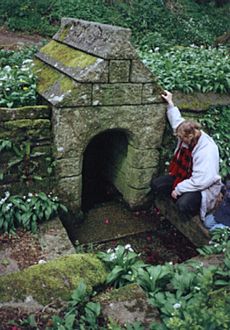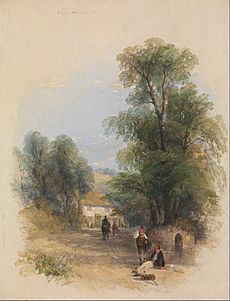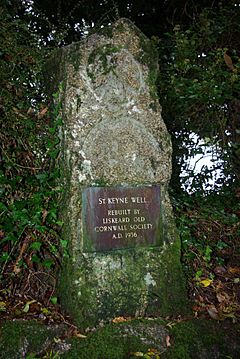Keyne facts for kids
Keyne (pronounced like "cane" or "keen-uh") was a special holy woman who lived a long time ago, in the 400s. People say she traveled a lot through what is now South Wales and Cornwall. She was also known as Keane, Kayane, Keyna, Cenau, Cenedion, or Ceinwen.
Contents
The Life of Saint Keyne
Keyne was one of the many daughters of a Welsh king named Brychan. He ruled a place called Brycheiniog in what is now South Wales. (Some old stories even say he had 24 daughters, and all of them were saints!)
Even though she was very beautiful and many people wanted to marry her, Keyne decided to dedicate her life to religion. She promised to remain a virgin, which is why her Welsh name was Cain Wyry, meaning "Keyne the Maiden."
Her Journeys and Settlements
Stories say Keyne traveled widely. She is believed to have started several small churches or prayer places. These include Llangeinor in Glamorgan, Llangunnor and Llangain in Dyfed, and Rockfield in Runston, Gwent.
Eventually, she is said to have crossed the Severn River into Cornwall. There, she lived as a hermitess for many years. A hermitess is a woman who lives alone, often in a quiet place, to focus on religious life. The village of St Keyne in Cornwall is named after her. It also has a church and a special holy well that share her name.
Around the year 490, Keyne is thought to have visited her nephew, Saint Cadoc, at St Michael's Mount. Cadoc convinced her to return to Wales. She settled in a spot where a healing spring appeared. This is where she eventually died. She passed away as a virgin on October 5th, either in 490 or 505. Llangeinor in Glamorgan is thought to be this place, as it has an ancient well that people still say has healing powers.
Saint Keyne's Legacy
Saint Keyne's special day, or feast day, is celebrated on October 8th. Sometimes it is also recorded as September 30th. She was the original patron saint of what is now St Martin-by-Looe (Penndrumm). She is also connected to the River Kenwyn in Truro.
The Famous Well Legend
However, her most famous and charming story is linked to the holy well in St Keyne, Cornwall, which is named after her. According to an old legend, if a married couple drinks from the well, the first one to take a sip will be the one who "rules" or has the upper hand in the marriage. This story was well-known even in the Middle Ages. It was made even more famous in a poem called "The Well of St Keyne" by Robert Southey.
The Serpent Story
Some people also say that Saint Keyne is the patron saint of Keynsham in Somerset. The story goes that she lived near the Avon, which was full of snakes and not a good place to live. After Saint Keyne prayed very hard, the snakes turned into stone! This made the area safe for people. Today, these "stone snakes" are actually thought to be ammonites, which are fossils of ancient sea creatures. However, a similar story is also told about St. Hilda. Some people believe Keynsham might actually be named after "Ceagin's (Caega) Hamm" instead.
There is also a tradition that one of the altars in the Berkeley Chapel at Bristol Cathedral was dedicated to St Keyna.
St. Keyne's Well
The holy well of Saint Keyne is located about 0.8 kilometers (half a mile) southeast of St. Keyne's Church in Cornwall. It is now housed in a small building made of cut granite stones. The original building was from the 1500s. It was rebuilt in 1936 when the nearby road was made wider.
The Well's Plaque
A plaque next to the well describes the special power Saint Keyne is said to have given the water. The plaque reads: "The legend of Saint Keyne Well. Saint Keyne was a princess who lived about 600 AD. She laid on the waters of this well a spell thus described by Richard Carew in 1602 AD—'The quality that man or wife / Whom chance or choice attaines / First of this sacred stream to drinke / Thereby the mastery gains.'"
In Victorian times, the well was famous for giving the first married partner who tasted its water control in the marriage. There is also a ballad (a type of song or poem) called The Well of St Keyne written by Robert Southey. It is set to music that is an adaptation of the tune from the Helston Furry Dance.
See also
- St Ceinwen's Church, Cerrigceinwen – a church in Anglesey dedicated to her




